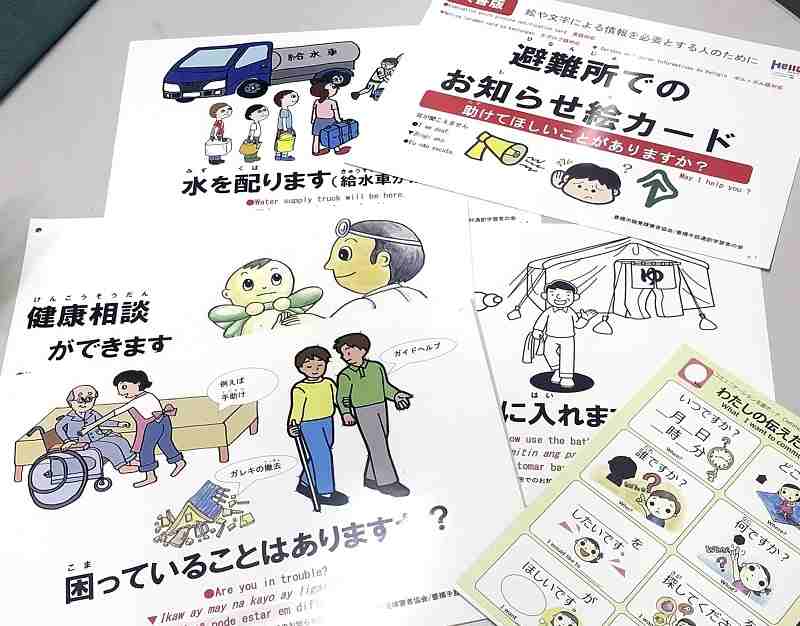
An apartment complex with a wheelchair-accessible ramp leading to the second floor in Kurashiki, Okayama Prefecture
15:19 JST, September 3, 2021
Grassroots initiatives to help the disabled evacuate in emergencies have been gaining traction across the country. The construction of wheelchair-accessible facilities, the distribution of cards with illustrations to facilitate communication with the hearing-impaired, and the holding of joint drills bringing together children and the disabled are just some of the ways communities are coming together to ensure the safety of their people should disaster strike.
When torrential rains devastated western Japan in 2018, the death toll hit 51 in Mabi, a town in Kurashiki, Okayama Prefecture. In June last year, an eight-unit apartment complex was erected in the town, with a wheelchair-accessible evacuation ramp that provides direct access to a unit on the second floor, which serves as a designated shelter open to all in the event of an emergency. The 30-meter-long ramp was designed with a gentle incline, so that wheelchair users can make the climb on their own.
The building was planned by Yukiko Tsuda, 57, who runs a nursing care facility in the town. Since many of the victims in the 2018 floods were elderly or disabled, Tsuda came up with the idea of building a residential complex that could become a safe haven in the event of a disaster. Construction costs were subsidized by a government grant and a crowd-funding campaign.

Illustrated cards distributed to evacuation shelters to help facilitate communication with the hearing-impaired
In normal times, the shelter unit functions as a space for building residents and other townspeople to meet and enjoy neighborly exchanges.
“If the space becomes familiar to many people, they will feel less of a psychological hurdle toward evacuating here in a disaster,” Tsuda said. “I hope we can help as many vulnerable individuals as possible.”
According to Cabinet Office data, disabled people were believed to have died at double the rate of able-bodied victims of the 2011 Great East Japan Earthquake.
But past disasters have shown that physical evacuation routes are not the only issue. It is also important that the disabled are provided with pertinent information in times of need, and a number of local governments have been launching initiatives that seek to ensure no one is left out of the loop.
In June, the municipal government of Gero in Gifu Prefectures made vests printed with the message, “I am hard of hearing — please help accordingly,” and distributed them to the hearing-impaired for wear at evacuation shelters. The city decided to introduce the vests after learning about a case in which food rations did not reach the hearing-impaired during torrential rains in July last year.
In 2014, Toyohashi Shuwa Network, a network of groups supporting the hearing impaired or promoting the use of sign language in Toyohashi, Aichi Prefecture, began making picture cards for distribution to shelters in the city explaining the handout of supplies, the setup of bathing facilities, and other support measures. The cards have since been introduced in about 30 municipalities, both in and out of the prefecture.
“Support tools for the hard-of-hearing are in short supply, so I hope to keep working to increase the reach [of the cards],” said Yasuichiro Hiramatsu, the sign-language network’s deputy head.
Other projects have sought to enlist the help of children, instead of relying solely on adults who tend to be away from local communities due to work or other reasons at the time of disasters.
Osaka-based nonprofit Yumekaze Kikin has been holding joint evacuation drills attended by students and disabled community members at local junior high schools since 2006. During the drills, students practice evacuating from their classrooms on the second floor to the school gym, together with visually impaired individuals and wheelchair users, thereby learning how to guide them. About 3,000 junior high school students have taken part in the drills, which have inspired some students to aspire to careers in welfare facilities.
“I want to live in a society where we can all help each other out in times of need,” said Shunsuke Abe, 38, an official of the nonprofit and a survivor of the 2011 earthquake.
"Society" POPULAR ARTICLE
-

M4.9 Earthquake Hits Tokyo, Neighboring Prefectures
-

Israeli Tourists Refused Accommodation at Hotel in Japan’s Nagano Pref., Prompting Protest by Israeli Embassy and Probe by Prefecture
-

M7.5 Earthquake Hits Northern Japan; Tsunami Waves Observed in Hokkaido, Aomori and Iwate Prefectures
-

Tsukiji Market Urges Tourists to Avoid Visiting in Year-End
-

High School in Kyoto Says Students Shoplifted during Recent School Trip to Bali, Indonesia
JN ACCESS RANKING
-

Tokyo Economic Security Forum to Hold Inaugural Meeting Amid Tense Global Environment
-

Keidanren Chairman Yoshinobu Tsutsui Visits Kashiwazaki-Kariwa Nuclear Power Plant; Inspects New Emergency Safety System
-

Imports of Rare Earths from China Facing Delays, May Be Caused by Deterioration of Japan-China Relations
-

University of Tokyo Professor Discusses Japanese Economic Security in Interview Ahead of Forum
-

Japan Pulls out of Vietnam Nuclear Project, Complicating Hanoi’s Power Plans
























